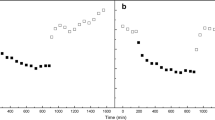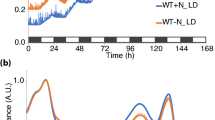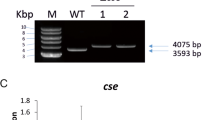Abstract
Mutant strains of the filamentous cyanobacterium Anabaena strain PCC 7120 ΔHup (dc-Q193S and dc-R284H) with amino acid substitutions located in the vicinity of the FeMo cofactor of nitrogenase possess nitrogenase activity with a hydrogen production rate of approximately 18 μmol Н2/(mg h), which is ~30% lower than that of the parental strain ΔHup. The photosynthetic activity of mutants is also reduced. Unlike the parental strain ΔHup, the dc-Q193S mutant shows a lower temperature optimum for hydrogen photoproduction. This difference is probably due to the lowered filament strength (fragmentation). Hydrogen photoproduction in mutants does not significantly differ from that of the parental strain in relation to the activation energy, light saturation constants (41–62 μmol quanta /(m2 s)), and acetylene-induced inhibition. However, in contrast to the parental strain, hydrogen photoproduction in the mutant strains is not inhibited by molecular nitrogen, i.e., amino acid substitutions cause significant changes in the reaction requiring eight electrons (N2 fixation). The possibility to use nitrogen or atmospheric air instead of argon in the hydrogen production is promising from the practical point of view, though reduced activity and increased fragility of filaments in the studied mutants limit the possibility of their practical use.







Similar content being viewed by others
REFERENCES
Prince, R.C. and Kheshgi, H.S., The photobiological production of hydrogen: potential efficiency and effectiveness as a renewable fuel, Crit. Rev. Microbiol., 2005, vol. 31, p. 19.
Tamagnini, P., Leitão, E., Oliveira, P., Ferreira, D., Pinto, F., Harris, D.J., and Lindblad, P., Cyanobacterial hydrogenases: diversity, regulation and applications, FEMS Microbiol. Rev., 2007, vol. 31, p. 692.
Bothe, H., Schmitz, O., Yates, M.G., and Newton, W.E., Nitrogen fixation and hydrogen metabolism in cyanobacteria, Microbiol. Mol. Biol. R., 2010, vol. 74, p. 529.
Dutta, D., De, D., Chaudhuri, S., and Bhattacharya, S., Hydrogen production by cyanobacteria, Microb. Cell Fact., 2005, vol. 4, p. 1.
Allahverdiyeva, Y., Leino, H., Saari, L., Fewer, D.P., Shunmugam, S., Sivonen, K., and Aro, E.M., Screening for biohydrogen production by cyanobacteria isolated from the Baltic Sea and Finnish lakes, Int. J. Hydrogen Energ., 2010, vol. 35, p. 1117.
Dasgupta, C.N., Gilbert, J.J., Lindblad, P., Heidorn, T., Borgvang, S.A., Skjanes, K., and Das, D., Recent trends on the development of photobiological processes and photobioreactors for the improvement of hydrogen production, Int. J. Hydrogen Energ., 2010, vol. 35, p. 10218.
Kosourov, S., Murukesan, G., Seibert, M., and Allahverdiyeva, Y., Evaluation of light energy to H2 energy conversion efficiency in thin films of cyanobacteria and green alga under photoautotrophic conditions, Algal Res., 2017, vol. 28, p. 253.
Tsygankov, A.A., Fedorov, A.S., Kosourov, S.N., and Rao, K.K., Hydrogen production by cyanobacteria in an automated outdoor photobioreactor under aerobic conditions, Biotechnol. Bioeng., 2002, vol. 80, p. 777.
Wolk, P., Heterocyst formation, Annu. Rev. Genet., 1996, vol. 30, p. 59.
Masukawa, H., Sakurai, H., Hausinger, R.P., and Inoue, K., Increased heterocyst frequency by patN disruption in Anabaena leads to enhanced photobiological hydrogen production at high light intensity and high cell density, Appl. Microbiol. Biotechnol., 2017, vol. 101, p. 2177.
Tsygankov, A., Serebryakova, L., Rao, K., and Hall, D., Acetylene reduction and hydrogen photoproduction by wild type and mutant strains of Anabaena at different CO2 and O2 concentrations, FEMS Microbiol. Lett., 1998, vol. 167, p. 13.
Mikheeva, L.E., Schmitzh, O., Shestakov, S.V., and Bothe, H., Mutants of the cyanobacterium Anabaena variabilis altered in hydrogenase activities, Z. N-aturforsch. C, 1995, vol. 50, p. 505.
Happe, T., Schutz, K., and Bohme, H., Transcriptional and mutational analysis of the uptake hydrogenase of the filamentous cyanobacterium Anabaena variabilis ATCC 29413, J. Bacteriol., 2000, vol. 182, p. 1624.
Lindberg, P., A hydrogen-producing, hydrogenase-free mutant strain of Nostoc punctiforme ATCC 29133, Int. J. Hydrogen Energ., 2002, vol. 27, p. 1291.
Yoshino, F., Ikeda, H., Masukawa, H., and Sakurai, H., High photobiological hydrogen production activity of a Nostoc sp. PCC 7422 uptake hydrogenase-deficient mutant with high nitrogenase activity, Mar. Biotechnol., 2007, vol. 9, p. 101.
Khetkorn, W., Lindblad, P., and Incharoensakdi, A., Inactivation of uptake hydrogenase leads to enhanced and sustained hydrogen production with high nitrogenase activity under high light exposure in the cyanobacterium Anabaena siamensis TISTR 8012, J. Biol. Eng., 2012, vol. 6, p. 1.
Nyberg, M., Heidorn, T., and Lindblad, P., Hydrogen production by the engineered cyanobacterial strain Nostoc PCC 7120 ΔhupW examined in a flat panel photobioreactor system, J. Biotechnol., 2015, vol. 215, p. 35.
Kosourov, S., Leino, H., Murukesan, G., Lynch, F., Sivonen, K., Tsygankov, A.A., and Allahverdiyeva, Y., Hydrogen photoproduction by immobilized N2-fixing cyanobacteria: understanding the role of the uptake hydrogenase in the long-term process, Appl. Environ. Microb-iol., 2014, vol. 80, p. 5807.
Masukawa, H., Sakurai, H., Hausinger, R.P., and Inoue, K., Sustained photobiological hydrogen production in the presence of N2 by nitrogenase mutants of the heterocyst-forming cyanobacterium Anabaena,Int. J. Hydrogen Energ., 2014, vol. 39, p. 19444.
Laurinavichene, T., Tekucheva, D., Laurinavichius, K., Ghirardi, M., Seibert, M., and Tsygankov, A., Towards the integration of dark and photo fermentative waste treatment. 1. Hydrogen photoproduction by purple bacterium Rhodobacter capsulatus using potential products of starch fermentation, Int. J. Hydrogen Energ., 2008, vol. 33, p. 7020.
Lyubimov, V.I., L’vov, N.P., and Khristin, B.I., Modification of microdiffusion method for ammonium determination, Prikl. Biokhim. Mikrobiol., 1968, vol. 4, p. 120.
Shestakov, S.V. and Mikheeva, L.E., Genetic control of hydrogen metabolism in cyanobacteria, Russ. J. Genet., 2006, vol. 42, p. 1512.
Silverman, S.N., Kopf, S.H., Bebout, B.M., Gordon, R., and Som, S.M., Morphological and isotopic changes of heterocystous cyanobacteria in response to N2 partial pressure, Geobiology, 2018, vol. 17, p. 60.
Bauer, C.C., Buikema, W.J., Black, K., and Haselkorn, R., A short-filament mutant of Anabaena sp. strain PCC 7120 that fragments in nitrogen-deficient medium, J. Bacteriol., 1995, vol. 177, p. 1520.
Burnat, M., Herrero, A., and Flores, E., Compartmentalized cyanophycin metabolism in the diazotrophic filaments of a heterocyst-forming cyanobacterium, Proc. Natl. Acad. Sci. USA, 2014, vol. 111, p. 3823.
Herrero, A., Stavans, J., and Flores, E., The multicellular nature of filamentous heterocyst-forming cyanobacteria, FEMS Microbiol. Rev., 2016, vol. 40, p. 831.
Bornikoel, J., Carrión, A., Fan, Q., Flores, E., Forchhammer, K., Mariscal, V., Mullineaux, C.W., Pezer, R., Silber, N., Wolk, C.P., and Maldener, I., Role of two cell wall amidases in septal junction and nanopore formation in the multicellular cyanobacterium Anabaena sp. PCC 7120, Front. Cell. Infect. Microbiol., 2017, vol. 7, p. 366.
Laurinavichene, T.V., Tsygankov, A.A., and Gogotov, I.N., Similarities and differences between alternative and Mo-containing nitrogenases in Rhodobacter capsulatus cells, Prikl. Biokhim. Mikrobiol., 1994, vol. 30, p. 389.
Liang, J. and Burris, R.H., Interactions among nitrogen, nitrous oxide, and acetylene as substrates and inhibitors of nitrogenase from Azotobacter vinelandii,Biochemistry, 1988, vol. 27, p. 6726.
Lichtl, R.R., Bazin, M.J., and Hall, D.O., The biotechnology of hydrogen production by Nostoc flagellifo-rme grown under chemostat conditions, Appl. Microbiol. Biotechnol., 1997, vol. 47, p. 701.
Funding
The adjustment of methods and obtaining of preliminary experimental data were supported by the Russian Foundation for Basic Research (project no. 15-54-50032). Data clarification, repetition, and analysis, as well as the manuscript preparation, were supported by the Russian Science Foundation (project no. 19-14-00255).
Author information
Authors and Affiliations
Corresponding author
Ethics declarations
The authors declare that they have no conflict of interest. This article does not contain any studies with human participants or animals performed by any of the authors.
Additional information
Translated by N. Statsyuk
Abbreviations: AA medium—Allen and Arnon medium; Chl—chlorophyll.
Rights and permissions
About this article
Cite this article
Romanova, A.I., Laurinavichene, T.V. & Tsygankov, A.A. Features of Anabaena PCC 7120ΔHUP Mutants with Amino Acid Substitutions in Nitrogenase. Russ J Plant Physiol 67, 386–395 (2020). https://doi.org/10.1134/S1021443720010161
Received:
Revised:
Accepted:
Published:
Issue Date:
DOI: https://doi.org/10.1134/S1021443720010161




